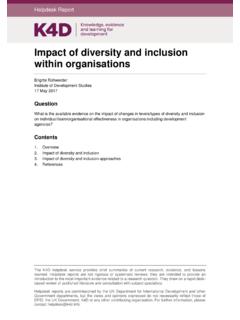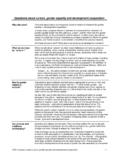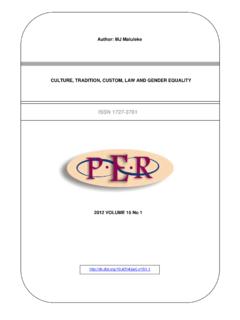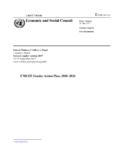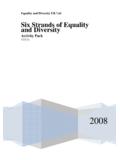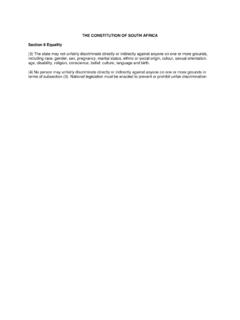Transcription of SOCIAL ATTITUDES TO GENDER EQUALITY IN AUSTRALIA
1 SOCIAL ATTITUDES TO. GENDER EQUALITY IN. AUSTRALIA . Part 1: Quantitative Findings Mark Evans, Virginia Haussegger AM, Max Halupka and Pia Rowe. 50/50 BY 2030 FOUNDATION. 1. 2. 50/50 BY 2030 FOUNDATION. 3. CONTENTS. Contents 4. List of figures and tables 5. About the 50/50 by 2030 Foundation 6. About this report 7. Foreword 9. Executive Summary 11. INTRODUCTION 17. Purpose 17. Approach 18. How to interpret the quantitative data in this report 18. Structure of the report 18. 1. CORE NARRATIVES ON GENDER EQUALITY IN AUSTRALIA 20. Is inequality between women and men still a problem in AUSTRALIA today? 20. The rhetoric-reality gap unpacking Australian ATTITUDES on GENDER EQUALITY 20. How do Australians understand sexism?
2 21. In which areas of Australian society is sexism most prevalent? 25. Have men been forgotten in the struggle for GENDER EQUALITY ? 27. Are male moderates misogynists or critical thinkers? 28. Male millennial traditionalists and the gaming culture 31. Regional AUSTRALIA leads the way on positive ATTITUDES to GENDER EQUALITY 33. 2. ANALYSIS BY GENDER 34. 3. ANALYSIS BY GENERATION 38. 4. ANALYSIS OF BELIEFS BY TIME SPENT ONLINE 46. IN CONCLUSION: TRENDING TOWARDS TRADITIONALISM BACKLASH OR BACKSLIDE? 50. REFERENCES 54. Appendix 1: Methodology and sampling 56. Appendix 2: Questionnaire 60. 4. LIST OF FIGURES AND TABLES FIGURES. Figure 1. SOCIAL ATTITUDES to GENDER inequality in AUSTRALIA since 2009 20. Figure 2.
3 Australian perspectives on GENDER EQUALITY 20. Figure 3. Which areas of society are perceived to be the most sexist AUSTRALIA and Europe compared 25. Figure 4. GENDER alignment with the moderate perspective 30. Figure 5. Positive and negative ATTITUDES to GENDER EQUALITY in regional and metropolitan AUSTRALIA (by GENDER ) 33. Figure 6. Survey sample composition 59. TABLES. Table 1. Should GENDER EQUALITY be a policy priority in AUSTRALIA ? (by GENDER and generation) 27. Table 2. GENDER EQUALITY strategies in the workplace do not take men into account (by generation) 27. Table 3. Men and boys are increasingly excluded from measures to improve GENDER EQUALITY (by generation) 28. Table 4. Political correctness gives women an advantage in the workplace (by generation) 28.
4 Table 5. Political correctness means I cannot say openly what I think about GENDER EQUALITY (by generation) 28. Table 6. Traditional aspects of the moderate position reduced by principle component analysis 30. Table 7. Length of time spent gaming and traditional views on GENDER EQUALITY issues (by GENDER and generation) 31. Table 8. Is inequality between men and women (including boys and girls) still a problem in AUSTRALIA today? 34. Table 9. Has your GENDER ever negatively impacted your work/career in any way? 34. Table 10. Do men and women have the same access to career opportunities in AUSTRALIA ? 34. Table 11. Choose three areas of society where sexism is most widespread 35. Table 12. Who should be responsible for addressing everyday sexism in AUSTRALIA ?
5 35. Table 13. Proportion of respondents who agree or strongly agree with the following statements (values) 36. Table 14. Proportion of respondents who agree or strongly agree with the following statements (values) 37. Table 15. Is inequality between men and women (including boys and girls) still a problem in AUSTRALIA today? 38. Table 16. Has your GENDER ever negatively impacted your work/career in any way? (by generation) 38. Table 17. Do men and women have the same access to career opportunities in AUSTRALIA ? (by generation) 38. Table 18. Choose three areas of society where sexism is most widespread? (by generation) 39. Table 19. Who should be responsible for addressing everyday sexism in AUSTRALIA ? 39. Table 20.
6 Proportion of respondents who agree or strongly agree with the following statements (by generation) 40. Table 21. Proportion of respondents who agree or strongly agree with the following statements (by generation) 41. Table 22. Proportion of male respondents who agree or strongly agree with the following gendered statements (by generation) 42. Table 23. Proportion of male respondents who agree or strongly agree with the following statements (by generation) 33. Table 24. Proportion of female respondents who agree or strongly agree with the following statements (by generation) 44. Table 25. Proportion of female respondents who agree or strongly agree with the following statements (by generation) 45. Table 26. Average time spent online by GENDER 46.
7 Table 27. Average time spent online by generation 46. Table 28. Average time spent online by respondents who agree or strongly agree with the following statements 47. Table 29. Proportion of respondents who agree or strongly agree with the following statements 48. 5. ABOUT THE 50/50 BY 2030 FOUNDATION. The world will never realize 100 per cent of its goals if 50 per cent of its people cannot realize their full potential. When we unleash the power of women, we can secure the future for all. Ban Ki-moon, UN Secretary-General 2015. The 50/50 by 2030 Foundation is a bold new GENDER EQUALITY initiative established by the Institute for Governance and Policy Analysis (IGPA), at the University of Canberra, AUSTRALIA .
8 So, why 50/50'? Well, in a word - it's time. And why the year 2030? Because, we're running out of time. None of us can wait the 170 years the World Economic Forum estimates it will take to reach economic GENDER We believe the past few decades have seen a global awakening to the value of GENDER EQUALITY , and momentum for change is building. However, increasingly complex SOCIAL and organisational structures mean new thinking is needed to ensure that progress towards GENDER diversity and the maximisation of human capital does not falter. The Foundation was officially launched by the Minister for Women, Senator the Hon Michaelia Cash, and Dame Quentin Bryce AD CVO on 12 September 2017 at the Museum of Australian Democracy, Canberra.
9 Backed by world class research expertise, we aim to develop evidence based theory and leading practice on the role of women in strengthening public administration and improving governance and national well-being. We delight in partnership and collaboration. And we excel in innovative program design. Our bespoke training modules;. seminars, and events aim to challenge the prevailing discourse around women, power and public leadership. As such, the 50/50 Foundation is a rich resource for local, national and international governments; political parties; public sector and civil service administrations, in supporting their efforts to achieve GENDER parity in leadership by the year 2030. 1. World Economic Forum (2017), GENDER inequality is 170 years away.
10 We cannot wait that long. Retrieved 27 August 2018 from: https://www. 6. ABOUT THIS REPORT. From Girls to Men: SOCIAL ATTITUDES to GENDER EQUALITY issues in AUSTRALIA is a research program hosted by the 50/50 by 2030 Foundation at the University of Canberra. The research program is distinctive in at least four ways. Firstly, it is the first research program in AUSTRALIA to combine a large-scale national quantitative survey with nation-wide focus groups and big data analysis of SOCIAL media activity on GENDER EQUALITY issues. Secondly, it studies the ATTITUDES of boys and girls, men and women to GENDER issues relating to EQUALITY and empowerment. Thirdly, it investigates attitudinal patterns by generational, mainstream and diversity groups.
